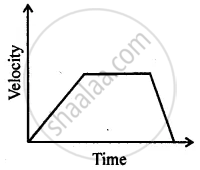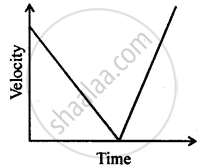Advertisements
Advertisements
Question
Multiple choice Question. Select the correct option.
A body dropped from the top of a tower reaches the ground in 4s. Height of the tower is
Options
39.2 m
44.1 m
58.8 m
78.4 m
Solution
78.4 m
Explanation:
Initial velocity = u = 0
Time = t = 4s
As body falls downards,
so acceleration = a = + g = a = + 9.8 ms−2
(Distance) S = ut + 1/2 at
S = (0) (4) + 1/2 × 9.8 × (4)3
s = 0 + 1/2 × 9.8 × 16
S = 9.8 × 8 = 78.4 m
APPEARS IN
RELATED QUESTIONS
When will you say a body is at non-uniform acceleration?
Name the quantity which is measured by the area occupied under the velocity-time graph.
Find the initial velocity of a car which is stopped in 10 seconds by applying brakes. The retardation due to brakes is 2.5 m/s2.
Write three equations of uniformly accelerated motion relating the initial velocity (u), final velocity (v), time (t), acceleration (a) and displacement (S).
How can you find the following?
Acceleration from velocity – time graph.
Can you suggest a real-life example about the motion of a body from the following velocity – time graph?

Can you suggest a real-life example about the motion of a body from the following velocity – time graph?

A packet is dropped from a stationary helicopter, hovering at a height ‘h’ from ground level, reaches the ground in 12s. Calculate
- the value of h
- final velocity of packet on reaching the ground. (Take g = 9.8 ms−2)
Draw a velocity versus time graph of a stone thrown vertically upwards and then coming downwards after attaining the maximum height.
When will you say a body is at uniform acceleration?
